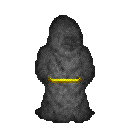Bienvenue invité ( Connexion | Inscription )
  |
 23 Oct 2007, 18:13 23 Oct 2007, 18:13
Message
#1
|
|
 Macbidouilleur de bronze !   Groupe : Membres Messages : 325 Inscrit : 22 Mar 2003 Lieu : Marseille Membre no 6 788 |
Bonsoir à tous,
Quelqu'un saurait t il comment faire (en cocoa) pour récupérer les composantes RVB d'un pixel affiché à l'écran (de coordonnées données)? Merci d'avance. -------------------- |
|
|
|
 23 Oct 2007, 20:14 23 Oct 2007, 20:14
Message
#2
|
|
 Terminaltor Moderating Machine      Groupe : Admin Messages : 24 449 Inscrit : 25 Oct 2002 Lieu : Jeumont (59) Membre no 4 319 |
Moi je sais, mais c'est du Carbon, pas du Cocoa...
CODE CGDirectDisplayID display = kCGDirectMainDisplay; char pixC[4]; void *pix = CGDisplayAddressForPosition(display,i,j); memcpy(pixC,pix,4); NSLog(@"R: %3d; G: %3d; B: %3d",pixC[2],pixC[1],pixC[0]); bits 1-8 -> composante "bleu" bits 9-16 -> composante "vert" bits 17-24 -> composante "rouge" bits 25-32 -> inutilisé -------------------- I think therefore I Mac
|
|
|
|
 23 Oct 2007, 21:25 23 Oct 2007, 21:25
Message
#3
|
|
|
Adepte de Macbidouille  Groupe : Membres Messages : 244 Inscrit : 10 May 2002 Membre no 2 433 |
En fait,
CGDisplayAddressForPosition : n'est pas du Carbon mais du langage quartz pour être plus précis du CoreGraphic. Il se trouve dans : ApplicationServices.framework et non dans le carbon.framework ;-) Dans le cas d'un NSView sans écran complet et si on veut faire du cocoa pur : NSPoint realPoint = NSMakePoint(posX+6,posY+6); [self lockFocus]; NSColor *color = NSReadPixel(realPoint); [self unlockFocus]; Le [self lockFocus]; est important sinon plantage. Philippe. Ce message a été modifié par Phili - 23 Oct 2007, 21:30. -------------------- |
|
|
|
 23 Oct 2007, 21:45 23 Oct 2007, 21:45
Message
#4
|
|
 Terminaltor Moderating Machine      Groupe : Admin Messages : 24 449 Inscrit : 25 Oct 2002 Lieu : Jeumont (59) Membre no 4 319 |
CITATION(Phili @ 23 Oct 2007, 22:25) [snapback]2400687[/snapback] En fait, CGDisplayAddressForPosition : n'est pas du Carbon mais du langage quartz pour être plus précis du CoreGraphic. Il se trouve dans : ApplicationServices.framework et non dans le carbon.framework ;-) Dans le cas d'un NSView sans écran complet et si on veut faire du cocoa pur : NSPoint realPoint = NSMakePoint(posX+6,posY+6); [self lockFocus]; NSColor *color = NSReadPixel(realPoint); [self unlockFocus]; Le [self lockFocus]; est important sinon plantage. Philippe. Avec un "s" (CoreGraphics) C'est vrai que j'ai un peu tendance à appeler Carbon tout ce qui n'est pas Cocoa Mais là pour une fois c'est vrai Extrait de Carbon.h : CODE #ifndef __APPLICATIONSERVICES__ #include <ApplicationServices/ApplicationServices.h> #endif C'est donc bien une partie de Carbon -------------------- I think therefore I Mac
|
|
|
|
 23 Oct 2007, 22:20 23 Oct 2007, 22:20
Message
#5
|
|
|
Adepte de Macbidouille  Groupe : Membres Messages : 244 Inscrit : 10 May 2002 Membre no 2 433 |
Philippe. -------------------- |
|
|
|
 1 Nov 2007, 19:19 1 Nov 2007, 19:19
Message
#6
|
|
 Macbidouilleur de bronze !   Groupe : Membres Messages : 325 Inscrit : 22 Mar 2003 Lieu : Marseille Membre no 6 788 |
CITATION(schlum @ 23 Oct 2007, 20:14) [snapback]2400566[/snapback] Moi je sais, mais c'est du Carbon, pas du Cocoa... CODE CGDirectDisplayID display = kCGDirectMainDisplay; char pixC[4]; void *pix = CGDisplayAddressForPosition(display,i,j); memcpy(pixC,pix,4); NSLog(@"R: %3d; G: %3d; B: %3d",pixC[2],pixC[1],pixC[0]); bits 1-8 -> composante "bleu" bits 9-16 -> composante "vert" bits 17-24 -> composante "rouge" bits 25-32 -> inutilisé Ok merci Par contre ya une ptite erreur, c'est plutôt : CODE NSLog(@"R: %3d; G: %3d; B: %3d",pixC[1],pixC[2],pixC[3]); Et puis je comprend pas trop le void* , pourquoi ne pas mettre char * ? Ce message a été modifié par Ne0 - 1 Nov 2007, 19:19. -------------------- |
|
|
|
 2 Nov 2007, 01:16 2 Nov 2007, 01:16
Message
#7
|
|
 Terminaltor Moderating Machine      Groupe : Admin Messages : 24 449 Inscrit : 25 Oct 2002 Lieu : Jeumont (59) Membre no 4 319 |
Oui oui, c'est "char *" bien sûr, sinon l'index ne veut rien dire !
Par contre, pour l'ordre, j'avais fait des tests, et c'était bien 2, 1, 0 -------------------- I think therefore I Mac
|
|
|
|
 23 Sep 2014, 10:42 23 Sep 2014, 10:42
Message
#8
|
|
 Terminaltor Moderating Machine      Groupe : Admin Messages : 24 449 Inscrit : 25 Oct 2002 Lieu : Jeumont (59) Membre no 4 319 |
Je uppe ce sujet, car CGDisplayAddressForPosition est manifestement deprecated depuis un bail, et renvoie maintenant NULL, d’où surprise quand j’en ai eu besoin à nouveau ^^
La nouvelle méthode : Code CGImageRef im = CGDisplayCreateImageForRect(kCGDirectMainDisplay,CGRectMake(i,j,1,1)); CFDataRef px = CGDataProviderCopyData(CGImageGetDataProvider(im)); UInt8 pixC[3]; CFDataGetBytes(px,CFRangeMake(0,3), pixC); NSLog(@"R: %3d; G: %3d; B: %3d",pixC[2],pixC[1],pixC[0]); CFRelease(px); CFRelease(im); C’est malheureusement sensiblement plus lent (seulement ~ 1000 pixels/s ici), mais l’accès direct au raw framebuffer semble maintenant interdit ; il faut donc passer par la copie des données dans un buffer externe, via la création d’une CGImage (donc allocation, puis release). J’ai essayé NSReadPixel aussi, mais ça me renvoie que des 0, peut-être que j’ai mal saisi quelque chose ^^ -------------------- I think therefore I Mac
|
|
|
|
  |
1 utilisateur(s) sur ce sujet (1 invité(s) et 0 utilisateur(s) anonyme(s))
0 membre(s) :
| Nous sommes le : 25th April 2024 - 20:01 |









